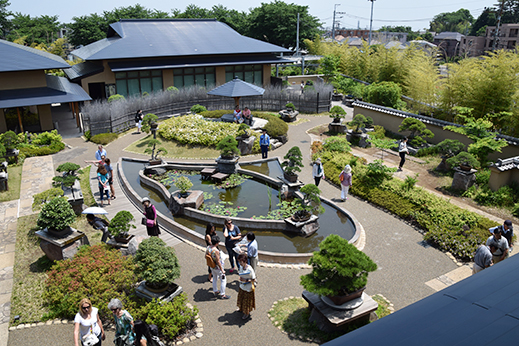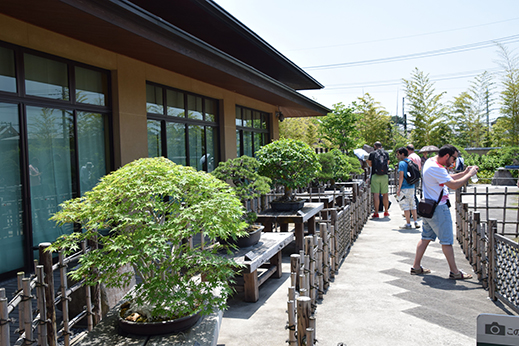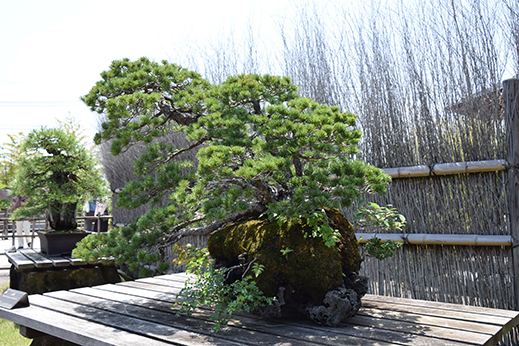 |
 |
 |
HOME > FOCUS > The Big World of Little Bonsai: The Omiya Bonsai Art Museum, Saitama |
 |
 |
Focus features two in-depth reviews each month of fine art, architecture and design exhibitions and events at art museums, galleries and alternative spaces around Japan. The contributors are non-Japanese art critics living in Japan. |
|
|
 |
 |
 |
The Big World of Little Bonsai: The Omiya Bonsai Art Museum, Saitama
Michael Pronko |
 |
Bonsai display in a Japanese reception room, featuring a pine with scroll painting and soe stone. Photo courtesy of the Omiya Bonsai Art Museum, Saitama |
Unlike other museums where the works may need a little dusting from time to time, at the Omiya Bonsai Art Museum every piece needs water, sun, and nourishment every day, as well as the occasional trimming, rewiring and root care. The bonsai artworks are, after all, alive. A visit to this museum of living sculptures, some of them hundreds of years old, is anything but "mini." It is a grand, expansive experience.
Inside the museum, the years of careful growing, masterful care and delicate attention are matched by the special exhibitions. The user-friendly facility is roomy, informative and relaxing, providing enough time and space to view the works and reflect on the years of creativity, sometimes spanning several lifetimes, that form the bonsai. One views a single moment of the life of the tree, knowing its history is sometimes longer than our own.
The special exhibition spaces display one tree each, taken from the museum's own collection or those of Japan's bonsai associations. There are also three larger rooms with tatami, tokonoma recessed alcoves, and display shelves. These replicas of traditional Japanese reception rooms showcase the bonsai even more beautifully, the entire space becoming the "frame" for the work. The rooms have space for small soe -- added objects, simple plants, scroll paintings or suiseki stones set into individually carved wooden trays that accentuate the main piece and expand the entire viewing experience.
 |
|
The outdoor garden offers a diversity of bonsai styles. Visitors can get close to the pieces and view them from many different angles, front and back. |
Another room is more museum-like, but in the best sense. It is filled with ukiyo-e woodblock prints, paintings, scrolls, and how-to manuals devoted to the many complex details of creating, growing and displaying bonsai trees. All these exhibits have excellent Japanese and English explanations of the art and history of bonsai.
The exhibits continue outdoors with well-designed walkways curving past a surprisingly large number of bonsai, all of them tremendously different. The natural sunlight reveals the intricacies of the pieces -- the twisting bark, the gnarly roots, soggy, soft moss, and the ceramic bases, some of which are simply a flat piece of pottery with the roots sprawling over the edge in fantastic shapes.
 |
|
Visitors are allowed to take photos of specific pieces only, but these are notable for their intricate designs and the variety of species. |
The variety is staggering. The museum's bonsai exhibitions follow the seasons, so that the most vibrant plants are set outside at the right time of year, while others are cared for in the nursery. Many plants, such as the Chinese quince, bear fruit. Others blossom or, as with the maples, turn colors at certain times of the year, so it is important to see those bonsai during the optimum period.
The most intriguing works are, of course, the older ones that have grown into highly distinctive shapes. When that happens, they often receive a special name -- "Dancing Lion," "Azure Dragon," "Crane Dance" -- whatever the tree may resemble or suggest. These are stunning pieces, some so large they need a rotating base to allow them to receive sun from different angles to continue growing and developing.
 |
|
Bonsai masters exert special efforts to get moss, ferns and other additions to grow from the base, as well as growing the main tree into a unique shape. |
The Omiya Bonsai Art Museum is also the center of a historical bonsai village that spreads out in all directions. It is an easy walk to the surrounding nurseries with the helpful map available at the museum counter. Most of the bonsai growers moved to the current location after the 1923 Kanto Earthquake. The nurseries needed space, as Tokyo was growing rapidly, and access to pure water, fertile soil, and plenty of sunshine.
Today the quiet, twisting lanes lead on from one nursery to the next. Each of these establishments has its own character and specializes in its own styles of bonsai, with tools, pots and suiseki stones also for sale. It is especially fascinating to see the extensive varieties and styles of younger bonsai waiting to grow into future masterpieces. A day spent at the museum and wandering the nurseries in the neighborhood offers compelling insights into one of Japan's most unique -- and living -- arts.
 |
|
 |
|
This maple has a special clump-style root system, with multiple trunks rising from the same roots. Originally, different seedlings were planted tightly together so as to grow into one.
|
|
In a more formal style of bonsai intended to resemble trees growing in nature, the branches get gradually shorter higher up, with a full shape at the base. The bark of the tree is given special treatment to develop color and texture.
All photos by Michael Pronko except where otherwise indicated.
|
 |
| | The Omiya Bonsai Art Museum, Saitama |
| | 2-24-3 Toro-cho, Kita-ku, Saitama City
Phone: 048-780-2091
Access: 5 minutes' walk from Toro Station on the JR Utsunomiya Line, or 10 minutes' walk from Omiya-Koen station on the Tobu Urban Park (Noda) Line |
|
 |
 |
Michael Pronko
Michael Pronko teaches American literature, film, art and music at Meiji Gakuin University. He has appeared on NHK, Sekai Ichiban Uketai Jugyo, and other TV programs. His publications include several textbooks and three collections of essays about Tokyo. He writes regular columns for Newsweek Japan, ST Shukan, The Japan Times, and for his own websites, Jazz in Japan and Essays on English in Japan. |
|
 |
|
|
 |
|
 |
|